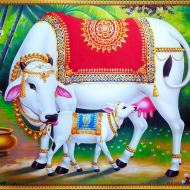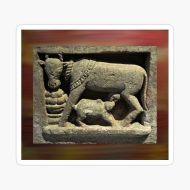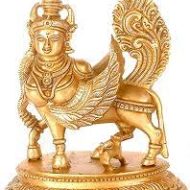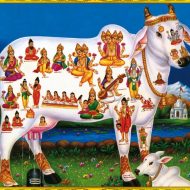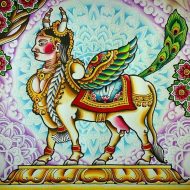Kamadhenu : The Divine Bovine
Listen
At a glance
| Description | |
|---|---|
| Origin | Indian Mythology |
| Classification | Animals |
| Family Members | Kashyap (Husband), Nandini, Dhenu, Harschika and Subhadra (Children) |
| Region | India |
| Associated With | Abundance, Prosperity |
Kamadhenu
Introduction
Kamadhenu, also known as Surabhi, holds a divine status in Hinduism as the mother of all cows. This miraculous bovine-goddess is revered for her ability to fulfill any desire of her owner and is often depicted as the progenitor of all cattle. In art, Kamadhenu is typically portrayed as a white cow with a female head, complete with breasts, bird-like wings, and a peafowl’s tail. It’s important to note that Kamadhenu is not independently worshipped as a goddess; rather, she is revered through the veneration of cows, seen as her earthly manifestations in Hindu culture.
The birth of Kamadhenu is recounted diversely in Hindu scriptures. Some accounts depict her emerging from the churning of the cosmic ocean, while others portray her as the daughter of the creator god Daksha and the spouse of the sage Kashyapa. Yet, other narratives suggest that Kamadhenu was possessed by either Jamadagni or Vashista, both revered ancient sages. Kings who attempted to seize her from these sages faced dire consequences for their actions. Kamadhenu holds a significant role in providing milk and milk products for her sage-master’s rituals, and she possesses the unique ability to produce formidable warriors to safeguard him. Apart from residing in the sage’s hermitage, she is also said to dwell in Goloka, the realm of cows, and Patala, the netherworld.
Physical Traits
Kamadhenu, also known as Kamaduh, serves as the generic embodiment of the sacred cow in Hinduism, revered as the ultimate source of prosperity. Kamadhenu is considered a manifestation of Devi, the Hindu Divine Mother, and is intimately connected with the bountiful Mother Earth (Prithvi), often symbolized as a cow in Sanskrit texts.
Within Kamadhenu’s form, all the deities are believed to reside: her four legs symbolize the sacred Vedas, while her horns represent the triune gods Brahma (at the tip), Vishnu (in the middle), and Shiva (at the base). Her eyes are equated with the sun and moon deities, her shoulders with the fire-god Agni and the wind-god Vayu, and her legs with the majestic Himalayas. This depiction of Kamadhenu is a common theme in poster art.
Another representation of Kamadhenu portrays her with the physique of a white Zebu cow, adorned with a crowned woman’s head, vibrant eagle wings, and a peacock’s tail. According to the Philadelphia Museum of Art, this form draws inspiration from the iconography of the Islamic Buraq, who is depicted with a horse’s body, wings, and a woman’s face. Modern poster art often portrays Kamadhenu in this distinctive fashion.
Family
The Ramayana narrates that Surabhi is the offspring of sage Kashyapa and Krodhavasa, Daksha’s daughter. In contrast, the Vishnu Purana and the Bhagavata Purana depict Surabhi as Daksha’s daughter and the consort of sage Kashyapa. These texts also identify her as the mother of cows and buffalos.
According to the Matsya Purana, Surabhi is the partner of Brahma and the mother of various beings, including the cow Yogishwari, the eleven Rudras, goats, swans, and certain animal species. Typically, she is celebrated as the mother of quadrupeds. In an alternative account, Surabhi is regarded as the mother of Amrita, cows, Brahmins, and the Rudras.
Other scriptures suggest that either Jamadagni or Vasishtha, or both, sheltered Surabhi in their hermitage for a time. During this period, certain kings attempted to seize her, only to face severe consequences at the hands of Kamadhenu herself. In this version, Kamadhenu played a vital role in the hermitage, providing milk and milk products for the sage, as well as the ability to summon fierce warriors for his protection.
In the Devi Bhagavata Purana, there’s a tale of Krishna and Radha feeling thirsty during their time together. To quench their thirst, Krishna created a cow named Surabhi and a calf called Manoratha from his left side. He milked the cow, but when the pot containing the milk fell and shattered, it transformed into the Kshirasagara, the Ocean of Milk. Miraculously, several cows emerged from Surabhi, which Krishna then gifted to his shepherd-friends, the Gopas. In reverence of this event, Krishna decreed that Surabhi would symbolize prosperity and be worshipped during Diwali.
Other names
The term Kamadhenu is derived from the Sanskrit word “Surabhi,” which literally means “the fragrant one.” This deity is often referred to as Matrika, who sets an Example or Sabala, the Spotted One and Kapila (the Red One.
Powers and Abilities
Kamadhenu, the divine and miraculous cow in Hindu mythology, possesses a range of powers and abilities that vary across different texts and traditions. First and foremost, Kamadhenu is renowned for her wish-fulfilling capabilities. She is believed to have the power to grant her owner whatever they desire, symbolizing abundance and prosperity.
Another notable ability of Kamadhenu is her capacity to provide an endless supply of milk. This milk serves as both a source of nourishment and a vital component in religious rituals and offerings. Kamadhenu is not only a bestower of material wealth but also a protector. In certain accounts, she can call upon fierce warriors to safeguard her owner or the sage she resides with, offering a shield against threats and dangers. Furthermore, Kamadhenu is revered as a symbol of divine energy, representing the feminine divine in Hindu culture. Her presence is believed to bring blessings and positive spiritual energy. Various parts of Kamadhenu’s body are associated with different deities, highlighting her connection to the divine. For instance, her horns are linked to Brahma, Vishnu, and Shiva, and her eyes to the sun and moon gods, underlining her sacred significance.
As an earthly embodiment of the divine cow, Kamadhenu is venerated in Hinduism, with the worship of cows seen as a way to honor her presence. She is regarded as the source of abundant resources, encompassing not only milk but also various other necessities. Beyond her material offerings, Kamadhenu holds spiritual significance. Her presence is believed to purify and elevate the spiritual ambiance, making her an integral part of many religious rituals. In summary, Kamadhenu’s powers and attributes may vary in different texts and traditions, but she consistently holds a revered place in Hindu culture, symbolizing blessings, prosperity, and the divine presence.
Modern Day Influence
Kamadhenu, the sacred cow of Hindu mythology, occasionally finds her presence in modern cultural and pop contexts.In the world of movies and television, Kamadhenu may not be as prevalent as some other mythological figures, yet she occasionally makes appearances. These appearances often take the form of traditional storytelling or are woven into larger mythological narratives, connecting viewers with the rich tapestry of Hindu mythology. In literature, modern Indian authors and poets have embraced Kamadhenu, incorporating her symbolism into their works. Through her representation, they convey profound themes of abundance, motherhood, and spirituality, adding depth to contemporary literary landscapes.
While modernity continues to shape Indian society, Kamadhenu’s legacy endures in festivals. In select regions, particularly rural areas, she is still venerated during festivals like Pongal and Makar Sankranti. These celebrations uphold the age-old rituals honoring cows and their indispensable role in agriculture, connecting contemporary generations with their agrarian roots. Kamadhenu’s symbolism extends to merchandise, where her image, alongside other Hindu symbols and deities, graces clothing, home decor, and accessories. These products cater to a global audience interested in Indian culture and spirituality, fostering an appreciation for the sacred cow’s symbolism.
Though not as ubiquitous as some mythological figures in modern pop culture, Kamadhenu’s symbolism continues to resonate with those who appreciate her association with prosperity, abundance, and the sacredness of cows in Hinduism.
Related Images
Frequently Asked Questions
What is lorem Ipsum?
I am text block. Click edit button to change this text. Lorem ipsum dolor sit amet, consectetur adipiscing elit. Ut elit tellus, luctus nec ullamcorper mattis, pulvinar dapibus leo.
What is lorem Ipsum?
I am text block. Click edit button to change this text. Lorem ipsum dolor sit amet, consectetur adipiscing elit. Ut elit tellus, luctus nec ullamcorper mattis, pulvinar dapibus leo.
What is lorem Ipsum?
I am text block. Click edit button to change this text. Lorem ipsum dolor sit amet, consectetur adipiscing elit. Ut elit tellus, luctus nec ullamcorper mattis, pulvinar dapibus leo.
What is lorem Ipsum?
I am text block. Click edit button to change this text. Lorem ipsum dolor sit amet, consectetur adipiscing elit. Ut elit tellus, luctus nec ullamcorper mattis, pulvinar dapibus leo.
What is lorem Ipsum?
I am text block. Click edit button to change this text. Lorem ipsum dolor sit amet, consectetur adipiscing elit. Ut elit tellus, luctus nec ullamcorper mattis, pulvinar dapibus leo.

